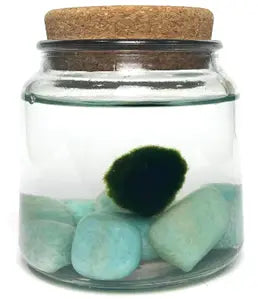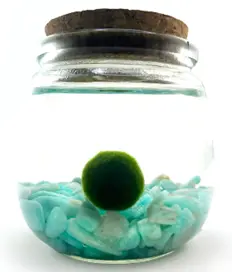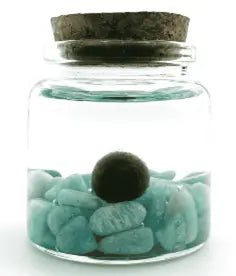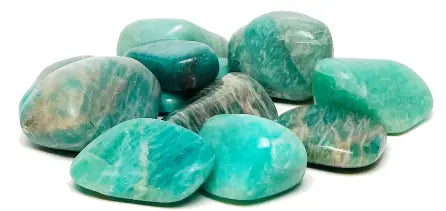
7 Must-Know Facts About Amazonite
At Moss Amigos, we've found a special combo: moss balls and Amazonite. Why? Well, Amazonite isn't just any stone. It's got something unique, something that makes it just right for sitting with our moss balls in a jar. Let's find out why!
Fact #1: The Science of Amazonite
Amazonite, a green tectosilicate mineral, falls under the microcline class of feldspar and is known for its grid-like silicate structures.
Its color spectrum, primarily green or blue-green, is not due to copper content as often misconceived but arises from small quantities of water in its crystalline structure. This gemstone is typically found in igneous rocks, such as granite.
Major deposits have been identified in Russia's Ilmensky Mountains, Brazil's Minas Gerais, and various locations within the USA, making it a mineral with a significant geographical spread.
Fact #2: A Glimpse into History
Amazonite's appeal has been around for a while. Its rich history dates back to ancient civilizations, most notably the Egyptians, who highly regarded the stone.
They believed in its protective powers and often included it in their jewelry, amulets, and even in the mosaic tiles decorating their tombs, attributing to its health and well-being properties.
The discovery of Amazonite among the treasures in Tutankhamun's tomb further underscores its esteemed status in ancient Egypt. These historical uses highlight the gemstone's enduring beauty and perceived value across different cultures and epochs.
Fact #3: The Name's Origin
The naming of Amazonite is shrouded in myths and misconceptions. Contrary to popular belief, it has no direct connection to the Amazon River.
Instead, the name is derived from a historical misassociation with green stones found in the Amazon region, which were later determined not to be Amazonite.
This naming error has persisted, linking the stone with the image of the powerful Amazonian warriors, further mystifying its origins and adding a layer of intrigue to its story.
Fact #4: Cultural Significance
Amazonite's significance extends beyond its physical beauty, holding a place of importance in various cultural traditions.
Indigenous cultures have utilized Amazonite in ceremonial ways, attributing to it the power to harmonize and balance life forces.
In modern times, some people believe in its stress-relieving properties, although such claims are grounded in personal experiences rather than scientific evidence.
This belief in the stone's metaphysical properties illustrates its enduring cultural relevance.
Fact #5: Formation and Discovery
Amazonite's formation is a process millions of years in the making, occurring under specific geological conditions that allow for the correct chemical composition and crystal structure to develop.
This process typically happens in areas where volcanic activity has occurred, leading to the creation of pegmatites, where Amazonite is often found.
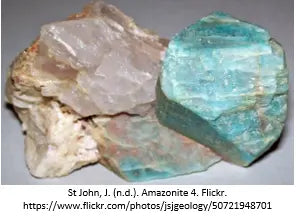
The discovery of amazonite deposits has fascinated scientists and gemologists, who have studied its formation to understand the complex processes that lead to the creation of such gemstones.
Fact #6: Uses and Appreciation
Amazonite's appeal isn't limited to its aesthetic beauty; it's also prized for its versatility in crafting and design. Beyond jewelry, it's utilized in decorative items, from tabletops to lamp bases, showcasing its ability to elevate everyday objects into art pieces.
The skill involved in cutting and polishing this gemstone to reveal its true beauty is a testament to its value in the gemological world, making it a sought-after material for artisans and collectors alike.
Fact #7: Durability and Timelessness
One of the key characteristics of Amazonite is its durability. With a Mohs hardness rating of around 6 to 6.5, it's relatively resistant to scratches and daily wear, making it an ideal material for jewelry and decorative items that stand the test of time.
This durability, combined with its timeless appeal, ensures that Amazonite remains a favorite across generations, maintaining its allure from ancient times to the modern day, a testament to its lasting beauty and resilience.
Explore Our Amazonite Moss Amigo Collection
Discover our Amazonite Moss Amigo Collection, featuring moss balls paired with the beauty of Amazonite.
Ideal for those seeking a significant, natural accent. Amazonite brings a soothing energy to any setting.
>>Discover it here<<
Compact and elegant, it fits perfectly in smaller spaces, with Amazonite adding a touch of tranquility.
>>Discover it here<<
A statement piece that combines lush greenery with the calming hue of Amazonite for a striking effect.
>>Discover it here<<
Small in size but rich in character, it's an ideal start or addition to any collection, enhanced by the peaceful presence of Amazonite.
>>Discover it here<<
Pure Amazonite is for those who appreciate the stone's natural beauty and soothing properties on its own.
>>Discover it here<<
Each piece in our collection brings the unique charm of Amazonite into your life, offering peace and natural beauty.
Conclusion
Wrapping up, it's clear that this combination of Moss Amigos moss balls and the Amazonite isn't just about aesthetics. It's a blend that brings a piece of the natural world's tranquility and ancient history into your living space.
Curious about these moss balls? Head over to our blog. We've got all the cool facts there. Read more about Moss Amigos moss ball facts on our blog.
References:
Dietrich, R. (1998, October 27). Feldspar | Properties, Uses, Types, & Facts. Encyclopedia Britannica. https://www.britannica.com/science/feldspar#:~:text=feldspar%2C%20any%20of%20a%20group,of%20the%20literature%20of%20mineralogy.

